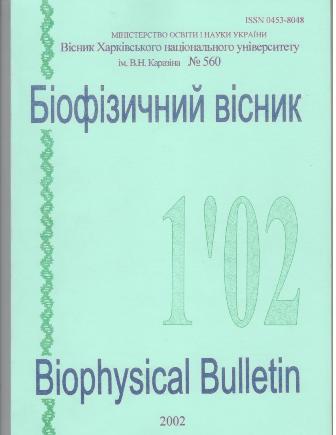Thermodynamic analysis of 3 -> 2 transition in oligonucleotide triple-helix complexes dAn-2dTm
Abstract
The work considers a possibility for thermodynamically describing the transition in oligomeric complexes dA15-2dT10 and dA19-2dT19 from the triplex form to the duplex+single strand (3—»2 transition), using the "Staggering Zipper" model and assuming the transition to be bimolecular reaction A 2B<=>AB+B. It was shown that upon physically grounded values of the transition thermodynamic parameters (ΔH23, ΔS:23, nucleation parameter β23, and others) the model describes adequately the experimental melting curves for triplexes with various lengths of oligonucleotide chains and different ionic conditions. As well, the work considers the effects of the dye covalently attached to dT10, intercalating between A·T pairs of the duplex on the transition parameters. Possible causes of great dispersion of the experimental data obtained for ΔH32 by different methods (DSC, ITC, van't Hoff analysis, and so on) are analyzed. It is shown that the disordering of the triplex and duplex ends (the so-called "end fraying") has a significant influence on the form of melting curves and on thermodynamic transition parameters.
Downloads
References
2. Roberts, R.W., Crothers, DM.// Proc. Nat. Acad. Sci. USA. 1996, v. 93, p. 4320-4325.
3. Plum, G.E., Breslauer, K.J.// J. Mol. Biol. 1995, v. 248, p. 679-695.
4. Plum, G.E., Park, Y.-W., Singleton, S.F., Dervan, P.B., Breslauer, K.J.// Proc. Nat. Acad. Sci. USA. 1990, v. 87, p. 9436-9440.
5. Pilch, D.S., Brousseau, R., Shafer, R.H // Nucl. Acids Research. 1990, v. 18, N 19, p. 5743-5750.
6. Hopkins, H.P., Hamilton, D.D., Wilson, W.D., Zon, G // J. Phys. Chem. 1993, v. 97. p. 6555-6563.
7. Kamiya, M., Torigoe, H., Shindo, H, Sarai, A.// J. Amer. Chem. Soc. 1996, v. 118, p. 4532-4538.
8. Pilch, D.S., Kirolos, M.A., Breslauer, K.J.// Biochemistry. 1995, v. 34, N 49, p. 16107-16124.
9. Xodo, L.E.// Eur. J. Biochem. 1995, v. 228, p. 918-926.
10. Zimm, B.H.// J. Chem. Phys. 1960, v. 33, p. 1349.
11. Applequist, J., Damle, V.// J. Chem. Phys. 1963, v. 39, p. 2719.
12. Applequist, J., Damle, V.// J. Amer. Chem. Soc. 1965, v. 87, N 7, p. 1450-1458.
13. Porschke, D., Eigen, M// J. Mol. Biol. 1971, v. 62, p. 361-381.
14. Porschke, D. // Biopolymers. 1971, v. 10, p. 1989-2013.
15. Blagoi, Yu.P., Zozulya, V.N., Egupov, S.A., Ryazanova, O.A., Shcherbakova, A.S.// Biophysical Bulletin 2001, N 2(9), p.10-16.
16. Massoulie, J.// Europ. J. Biochem. 1968, v. 3, p. 428.
17. Zozulya, V., Blagoi, Yu., Lober, G. et al.// Biophys. Chem. 1997, v. 65, p. 55-63.
18. Delisi, C, Crothers, D.M.// Biopolymers. 1971, v. 10, p. 1809-1827.
19. Зозуля, В.Н., Благой, Ю.П., Дубей, И.Я. и др.// Биополимеры и клетка. 1998. Т. 14, № 1, с. 1-8.
20. Makitruk, V.L., Yarmolik, S.N., Shalamay, A.S. et al.// Nucl. Acids. Symp. Ser. 1991, N 24, p. 244.
21. Kibler-Herzog. L., Kell, B., Zon, G, Shinozuka, K, Mizan, S., Wilson, W.D.//Nucl. Acids. Research. 1990, v. 18, N 12, p. 3545-3555.
22. Klump, H.// Ber. Bunsenges. Phys. Chem. 1978, v. 82, p. 805.
23. Marky, L.A., Breslauer, K.J.// Biopolymers. 1982, v. 21, p. 2185-2194.
24. Wilson, W.D., Hopkins, H.P., Mizan, S., Hamilton, D.D., Zon, G. // J. Am. Chem. Soc. 1994. v. 116, N 8, p. 3606-3609.
Authors who publish with this journal agree to the following terms:
- Authors retain copyright and grant the journal right of first publication with the work simultaneously licensed under a Creative Commons Attribution License that allows others to share the work with an acknowledgement of the work's authorship and initial publication in this journal.
- Authors are able to enter into separate, additional contractual arrangements for the non-exclusive distribution of the journal's published version of the work (e.g., post it to an institutional repository or publish it in a book), with an acknowledgement of its initial publication in this journal.
- Authors are permitted and encouraged to post their work online (e.g., in institutional repositories or on their website) prior to and during the submission process, as it can lead to productive exchanges, as well as earlier and greater citation of published work (See The Effect of Open Access).





